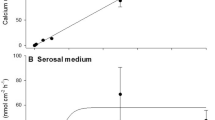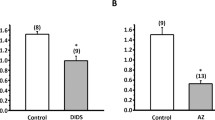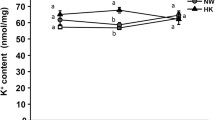Abstract
We present a new invertebrate model for the study of epithelial sodium transport in tight epithelia, the earthworm integument. Dissected segments of earthworm integument were mounted in modified Ussing chambers and perfused with either pond water (PW) or earthworm ringer solution (ERS) on the apical side. In order to investigate ion transport under near-in vivo physiological conditions, measurements were performed under current-clamp conditions by monitoring the transepithelial potential (V T), as well as the transepithelial resistance (R T). These were recorded continuously and the virtual short circuit current (I SC) was calculated. The integument has a high transepithelial resistance (R T=9,037±502 Ω cm2 for PW, n=24, and 11,055±1,320 Ω cm2 for ERS, n=32). V T was −3.7±2.2 mV for PW (n=24) and −1.5±1.0 mV for ERS (n=32), and I SC was −0.57±0.30 μA/cm2 for PW (n=24) and −0.44±0.24 μA/cm2 for ERS (n=32). Only under PW, but not under ERS conditions, was there a pronounced inhibition of I SC by low doses of amiloride or its analogues phenamil and benzamil. The resistance of the paracellular pathway was found to be very high. The terrestrial oligochaete Lumbricus seems especially adapted to the environmental conditions because it has an ultra-tight integument and a very fast up- and down-regulation of apical Na+ channels.







Similar content being viewed by others
References
Benos DJ, Awayda MS, Berdiev BK, Bradford AL, Fuller CM, Senyk O, Ismailov II (1996) Diversity and regulation of amilorid-sensitive Na+ channels. Kidney Int 49:1632–1637
Blazer-Yost BL, Helman SI (1997) The amiloride-sensitive epithelial Na+ channel: binding sites and channel densities. Am J Physiol Cell Physiol 41(3):C761–C769
Canessa CM, Horisberger JD, Rossier BC (1993) Epithelial sodium channel related to proteins involved in neurodegeneration. Nature 361:467–470
Carley WW (1975) Effects of brain removal on integumental water permeability and ion content of the earthworm Lumbricus terrestris L. Gen Comp Endocrinol 27:509–516
Carley WW (1978) Water economy of the earthworm Lumbricus terrestris L.: coping with the terrestrial environment. J Exp Zool 205:71–78
Clauss WG (2001) Epithelial transport and osmoregulation in annelids. Can J Zool-Rev Can Zool 79(2):192–203
Cornell JC (1982) Sodium and chloride transport in the isolated intestine of the earthworm, Lumbricus terrestris (L.). J Exp Biol 97:197–216
Cragoe EJJ, Kleyman TR, Simchowitz L (1992) Amiloride and its analogues—unique cation transport inhibitors. VCH Publishers, New York, NY
Dietz TH (1974) Active chloride transport across the skin of the earthworm, Lumbricus Terrestris L. Comp Biochem Physiol 49A:251–258
Dietz TH, Alvarado RH (1970) Osmotic and ionic regulation in Lumbricus terrestris L. Biol Bull 138:247–261
Garty H, Palmer LG (1997) Epithelial sodium channels: function, structure and regulation. Physiol Rev 77(2):359–396
Jensik P, Holbird D, Cox T (2002) Cloned bullfrog skin sodium (fENaC) and xENaC subunits hybridize to form functional sodium channels. J Comp Physiol B 172(7):569–576
Kirschner LB, Greenwald L, Kerstetter TH (1973) Effect of amiloride on sodium transport across body surface of freshwater animals. Am J Physiol 224:832–837
Kleyman TR, Cragoe EJ Jr (1988) Amiloride and its analogues as tools in the study of ion transport. J Membr Biol 105:1–21
Kleyman TR, Smith PR, Benos DJ (1994) Characterization and localization of epithelial Na+ channels in toad urinary bladder. Am J Physiol 266:C1105–C1111
Kunzelmann K, Kathofer S, Hipper A, Gruener DC, Greger R (1996) Culture dependent expression of Na+ conductance in airway epithelial cells. Pflügers Arch–Eur J Physiol 431(4):578–586
Lewis SA, Wills NK (1981) Interaction between apical and basolateral membranes during sodium transport across tight epithelia. In: Schultz SG (ed) Ion transport by epithelia. Raven Press, New York, NY, pp 93–107
Lewis SA, Eaton DC, Clausen C, Diamond JM (1977) Nystatin as a probe for investigating the electrical properties of a tight epithelium. J Gen Physiol 70:427–440
Licata A, Mauceri A (1998) Immunohistochemical localization of bioactive substances in the epidermis of the earthworm, Lumbricus terrestris (Annelida, Oligochaeta). Eur J Histochem 42:303–308
Liu L, Johnson WA, Welsh MJ (2003) Drosophila DEG/ENaC pickpocket genes are expressed in the tracheal system, where they may be involved in liquid clearance. PNAS 100(4):2128–2133
Navarte J, Finn AL (1985) Effects of intracellular sodium and potassium iontophoresis on membrane potentials and resistances in toad urinary bladder. J Membr Biol 84/1:1–8
Prusch RD, Otter T (1977) Annelid transepithelial ion transport. Comp Biochem Physiol 57A:87–92
Rossier BC, Pradervand S, Schild L, Hummler E (2002) Epithelial sodium channel and the control of sodium balance: interaction between genetic and environmental factors. Annu Rev Physiol 64(1):877–897
Schnizler M, Mastroberardino L, Reifarth F, Weber WM, Verrey F, Clauss W (2000) cAMP sensitivity conferred to the epithelial Na+ channel by alpha-subunit cloned from guinea-pig colon. Pflügers Arch 439(5):579–587
Schnizler M, Krumm S, Clauss W (2002) Annelid epithelia as models for electrogenic Na+ transport. Biochim Biophys Acta 1566:84–91
Weber WM, Dannemaier B, Clauss W (1993) Ion transport across leech integument. J Comp Physiol B 163:153–159
Weber WM, Blank U, Clauss W (1995) Regulation of electrogenic Na+ transport across leech skin. Am J Physiol 37:R605–R613
Acknowledgements
This study was supported by the Deutsche Forschungsgemeinschaft. The authors thank Margret Hündt and Christa Schwarz for excellent technical assistance. Siegfried Kristek provided the modified Ussing chambers and Bernhard Kahnert provided electrotechnical support. We thank Prof. Horst Brandt for his help with the statistical analyses.
Author information
Authors and Affiliations
Corresponding author
Additional information
Communicated by G. Heldmaier
Rights and permissions
About this article
Cite this article
Krumm, S., Goebel-Lauth, S.G., Fronius, M. et al. Transport of sodium and chloride across earthworm skin in vitro. J Comp Physiol B 175, 601–608 (2005). https://doi.org/10.1007/s00360-005-0023-1
Received:
Revised:
Accepted:
Published:
Issue Date:
DOI: https://doi.org/10.1007/s00360-005-0023-1




